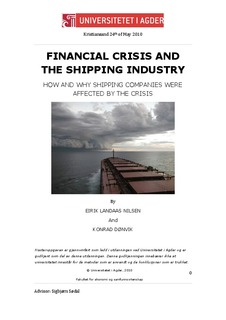| dc.description.abstract | The theoretical framework of this thesis includes macro arguments for trade,
shipping theory and definitions, including Martin Stopford’s comprehensive
shipping market model, and some theory and definitions on some of the financial
terms, such as gearing, financial and operating lease, used in this thesis.
The Baltic Dry Index (BDI) is a series of indices based on reports from
independent and competitive shipbrokers. Its purpose is to provide the shippers
and the ship-owners with unbiased information on freight rates, and it is thought
to be one of the most accurate indicators of economic development in the
shipping market.
Due to environmental considerations, new IMO regulations state that by the end
of 2010 all single-hulled tanker vessels should be phased out of the market and
only double-hulled vessels will be accepted. This will result in more ships being
scrapped or repurposed.
The force behind the financial crisis was subprime mortgages sold to a higher
rating than what they should have been, creating solvency and liquidity
problems for the banks and the financial sector. It is reasonable to say the crisis
started in the US, but it spread to other countries as well. The financial crisis led
to a decline in world consumption, and thus world trade and the demand for
shipping services decreased. The liquidity problems were faced by the shipping
industry as well, with reduced attaining of debt due to interbank lending
problems faced.
Frontline is one of the world’s biggest tanker companies in the bulk trade. The
Company has had a high debt to equity ratio during the period of 2004 to 2009
and the ratio peaked at 7.44 in 2007. The Company’s net income decreased from
$701M in 2008 to $105M in 2009 due to the decrease in voyage and time
charters. Revenues were down 46,1% from 2008 to 2009, which amounted to a
staggering $971M.
NAT operates in the tanker market and mainly transports crude oil. It is a fairly
young company, which was founded in 1995, but has had a strong growth focus
during its relatively short life. In contradiction to Frontline, NAT has a
philosophy of low gearing and has financed their growth through issuance of
common stock. Their debt to equity ratio was 0.2, 0.03 and 0.01 during the years
of the financial crisis. Though, the net income of the Company plummeted from
$119M in 2008 to $1M in 2009 due to low revenues and the cost of operating
expense, including depreciation, amounting to $113M.
Wilh. Wilhelmsen is the market leading company in RORO shipping. Due to the
recent financial crisis the Company has had to put 17 vessels into layup entering
2010. The debt to equity ratio has been relatively low; 1.17 in 2004, 1.90 by the
end of 2009 and peaking in 2008 at 2.56 due to the issuance of new debt. The
freight revenues of Wilh. Wilhelmsen were nearly halved from 2008 ($293M) to
2009 ($153M) due to the sharp decline in average freight rates and the low
utilization of the fleet.
Odfjell is a worldwide provider of transportation and storage of bulk liquid
chemicals, acids, edible oils and other special products. Odfjell’s extensive newbuilding
program resulted in an increase in the company’s debt to equity ratio,
which peak in 2008 at 2.59. The net result of the Company went from being
negative in 2007 to a positive $110.5M in 2009 due to the repeal of the
Norwegian tonnage tax system.
Golden Ocean is a dry bulk shipping company focusing on Panamax, Kamsarmax
and Capesize vessels. The Company has had a high debt to equity ratio during the
years 2004-2009, 5.52 in 2007 and 4.74 in 2008, but in 2009 it was down to just
1.06 due to a major increase in equity and a decrease in debt. Further, the
Company has had a return on capital employed peaking at 28.50% in 2007,
20.79% in 2008 and 18.73% in 2009. The revenue in 2009 was $350M, which
was a dismal result compared to $877M the year before.
Up until the crisis, the shipping industry saw a high degree of new-building,
which created to large a supply of vessels during the decline and forced ships
into layup.
The various segments have all experienced a decrease in freight rates, but the
chemical tanker market experienced the least volatile rates, which in turn hurt
the companies as they have had a large portion of their ships in the spot market.
Bunker cost increased freight rates and companies with hedges on bunker
incurred substantial losses when the crude oil price plummeted.
Chinese demand, especially for oil and iron ore, has been one of the main factors
driving the increased and decreased demand for vessels, both prior to and
during the financial crisis.
All the shipping companies analyzed, but NAT, have experienced prevailing low
share prices when comparing towards the BDI, BDTI, BCTI, OSEBX and the NYSE.
The NYSE and OSEBX did not incur as high a decline as the shipping companies,
making us believe the shipping industry was one of the losers in the midst and
end of the financial crisis. | en_US |
